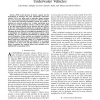Free Online Productivity Tools
i2Speak
i2Symbol
i2OCR
iTex2Img
iWeb2Print
iWeb2Shot
i2Type
iPdf2Split
iPdf2Merge
i2Bopomofo
i2Arabic
i2Style
i2Image
i2PDF
iLatex2Rtf
Sci2ools
TSMC
2008
2008
Navigation Technologies for Autonomous Underwater Vehicles
With recent advances in battery capacity and the development of hydrogen fuel cells, autonomous underwater vehicles (AUVs) are being used to undertake longer missions that were previously performed by manned or tethered vehicles. As a result, more advanced navigation systems are needed to maintain an accurate position over a larger operational area. The accuracy of the navigation system is critical to the quality of the data collected during survey missions and the recovery of the AUV. Many different methods for navigation in different underwater environments have been proposed in the literature. In this paper, the state of the art in navigation technologies for AUVs is investigated for theoretical and operational systems. Their suitability for use in different environments is compared and current limitations of these methods are identified. In addition, new approaches to address these current problems and areas for future research are suggested. Finally, it is concluded that only geop...
| Added | 15 Dec 2010 |
| Updated | 15 Dec 2010 |
| Type | Journal |
| Year | 2008 |
| Where | TSMC |
| Authors | L. Stutters, Honghai Liu, C. Tiltman, David J. Brown |
Comments (0)

